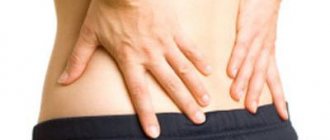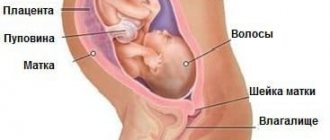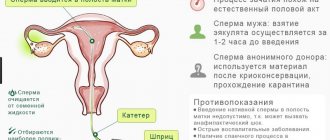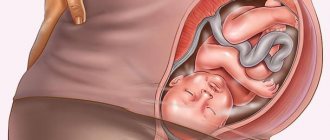Round ligament pain is usually sharp and occurs in the abdomen or at the level of the upper thigh. Some women may also experience pain radiating to the pelvis or groin area. This type of pain is more common on the right side because the uterus typically rotates to the right as pregnancy progresses.
Typically, expectant mothers begin to suffer from this problem during the second trimester, and it often lasts until delivery. Round ligament pain can be very uncomfortable, but it is normal and common.
Causes of pain
The uterus is usually pear-shaped. And on the sides there are two strips of fibromuscular tissue 10-12 cm long, which end in the groin. These are the two round ligaments, whose function is to support the uterus during pregnancy.
As the uterus grows during pregnancy, the round ligaments stretch. And certain actions can provoke their sharp contraction, which causes pain.
Ligaments are similar to muscles, except for the fact that they relax and contract much more slowly. Since the round ligaments of the uterus are greatly stretched during pregnancy, they become more vulnerable to stress.1 Sudden or poorly controlled movements, such as quickly squatting or trying to stand, coughing, laughing, etc., can create additional tension and pressure on them during pregnancy. Activities for long periods of time, such as walking too much, can also cause this problem.
Sudden contraction of the round ligament is the main cause of pain in the round ligament. However, in most cases it disappears within a few seconds.
How does pain feel?
Round ligament pain is uncomfortable, but in most cases it is tolerable and manageable. It usually feels like a sudden and sharp cramp in the abdomen. It most often occurs on the right side, but can also occur on both sides of the body. Each attack of pain usually lasts no more than a few seconds.
What else could this be, besides pain in the ligament?
Often other conditions related to the spine or musculoskeletal system can create similar pain. It can also be mistaken for appendicitis, abdominal cramps due to constipation, ovarian cysts and other neoplasms. 2
Symptoms of uterine ligamentous tension
When the round ligament of the uterus is stretched or contracted, a pregnant woman will experience different sensations. And her complaints will also be different. Most often, changes in the ligamentous apparatus of the uterus will manifest themselves:
- Dull, aching pain in the lower abdomen. They usually occur when the round ligaments are sprained. May resemble menstrual pain. A pregnant woman feels as if her stomach is pulling.
- Sudden stabbing pain. It appears during sudden movements of the body, when the enlarged uterus moves strongly and pulls the fibrous cords. Goes away quickly after changing position.
- Pain similar to contractions. They occur due to contraction of the round ligament of the uterus in response to severe stretching. Often also associated with sudden movements, short-term and, unlike ordinary contractions, irregular.
When the ligamentous apparatus is sprained, pain can occur in the groin, between the legs, and radiate to the thigh. This is due to the location of the fibromuscular cords. Most often, pregnant women are bothered by pain in the right side and leg, but they can also occur on the left and below on both sides.
First trimester
At this stage, the uterus is just beginning to enlarge. But pregnancy starts the process of restructuring the body, the center of gravity of the body shifts. Aching pain occurs in the lumbar region, which is also felt in the lower abdomen.
The uterine ligaments are stretched, which may be accompanied by aching or stabbing pain in the lower abdomen, side or upper legs.
Hormonal changes in the body also affect the digestive system. Intestinal bloating and discomfort may occur.
Second trimester
At a period of 3-6 months, the uterus of a pregnant woman grows intensively. The load on the ligamentous apparatus supporting it increases. Its constant stretching and tension is increasingly accompanied by pain in the lower and lateral areas of the abdomen.
Starting from the end of the second trimester, you may feel training contractions. They are usually painless, but sometimes discomfort occurs, especially if the expectant mother has increased anxiety.
Third trimester
From the 6th to the 9th month, the belly increases significantly. To support it, efforts are required from the uterine ligaments, muscles and skin. Usually by this time they adapt to the ever-increasing load and stretch without much pain. But with a sharp weight gain or increase in volume, complaints of pain in the lower abdomen will again appear.
During pregnancy, the abdomen is supported by three paired uterine ligaments.
When do you need to see a doctor?
The stabbing, sharp pain in the round ligament disappears as soon as the woman changes her position. But if the condition persists or is accompanied by severe abdominal pain or other serious symptoms, you should seek emergency medical help. This may suggest a serious obstetric problem such as severe preeclampsia, placental abruption, preterm labor, or another that is not directly related to pregnancy, such as appendicitis.
Call your doctor right away if you experience a dull, painful sensation in your abdomen or intermittent pain accompanied by:
- Cramping, severe pain, prolonged contractions (four or more contractions in an hour, even if they are not painful).
- Pain in the lower back, especially if the woman has never experienced it during pregnancy.
- Spotting, vaginal bleeding, or changes in the amount and type of vaginal discharge.
- Nausea, vomiting, chills, fever, or weakness.
- Burning or pain when urinating.
- Other danger signs include a feeling of pressure in the pelvic area, as if labor is beginning.
Causes of pathological abdominal pain
This symptom can be caused by many diseases and all of them are dangerous to the health of the woman and the fetus. The main diseases, symptoms and directions of treatment are given in the table:
Diseases
Symptoms
Help
| Miscarriage, premature birth | Acute, cramping pain in the lower abdomen and back, bleeding from the genital tract | Calling an ambulance, urgent hospitalization |
| Ectopic pregnancy | Sharp abdominal pain, usually on one side, bleeding, occurs early | Calling an ambulance, urgent hospitalization |
| Pyelonephritis | Chills, fever, frequent urination, pain in the upper legs, lower back | Consultation with a doctor, hospitalization in the urology department |
| Ligamentous cysts | Pain in the abdomen, groin area, thigh, between the legs, tumor-like protrusions of the labia. | Surgical treatment |
| Round ligament tumors | Increased pain as pregnancy progresses | Surgical treatment |
Ligamentous cysts
Occasionally, a cyst appears in the round ligament - a round formation filled with fluid. It is called a Nack cyst, named after the scientist who first described this disease. The cause of the formation of a Nack cyst is a violation of the development of the structures of the round ligament. Usually - in 90% of cases - cysts occur on the right side, which also explains pain on this side during pregnancy.
During pregnancy, a Naka cyst manifests itself as constant or periodic pain along the fibrous cord, a protrusion in the labia area.
It is often confused with an inguinal or femoral hernia, an enlarged lymph node, benign and malignant tumors, and vasodilatation.
An accurate diagnosis is established by ultrasound or magnetic resonance imaging.
Round ligament tumors
Both benign (fibromyomas, leiomyomas) and malignant (sarcomas) tumors can occur in this area. Sarcomas of the ligamentous apparatus develop extremely rarely. Pregnancy can serve as a trigger for tumor growth. As with cysts, their treatment is only surgical removal.
How to relieve round ligament pain?
Take a warm bath or apply a compress
Taking a warm bath can help relax tense muscles and reduce tissue swelling and soreness in the ligament area. Placing a warm compress on the side where the pain is felt may also help provide relief.
Reduce your activity level
It is obvious that especially active pregnant women are more prone to developing this problem. Cut the extra load to see the difference. And once you feel better, resume your activities gradually and slowly to avoid recurrence of pain.
Stretching exercises
Expectant mothers who experience persistent round ligament pain are usually advised to perform regular stretching exercises.
For example:
Get on your knees and place your hands on the floor. Now lower your head, move your arms forward and keep your pelvis in the air. This is the most common exercise recommended by doctors to reduce the intensity of painful sensations.
Stretching Exercises to Prevent Round Ligament Pain
Avoid sudden changes in body position
Also, before you put sudden stress on the ligament (such as from a strong cough, sneeze, or even laughing), flex your hips first to support the uterus and prevent stretching of the round ligament.
Don't stay in one position for too long
Avoid standing or sitting for long periods of time as this can put additional pressure on already stretched and vulnerable ligaments. If your job requires you to sit or stand for long periods of time, it is highly recommended that you take several breaks. You can also ask your doctor for a certificate if management prevents you from doing so due to your work schedule.
Practice yoga classes
The cow-cat ligament in yoga is a very useful exercise for eliminating round ligament pain in addition to strengthening tissue strength and stabilizing the pelvis:
Get on all fours, supporting your body weight with your knees and hands. Spread your fingers wide across the floor (pointing forward). Now inhale and round your back upward, allowing your head to drop—this is called cow pose. Then exhale, lowering your stomach down, and raising your head and gaze up, while stretching your back to stretch the ligaments - this is cat pose. Repeat several times.
Cow-Cat Yoga Ligament Helps Prevent Round Ligament Pain During Pregnancy
Try physical therapy
Many pregnant women look forward to prenatal massage, which helps relieve several common pregnancy-related discomforts, including round ligament pain. Massage helps to cope with painful sensations and support the body during childbirth and postpartum stress. There are various techniques that are commonly used during pregnancy, such as abdominal massage, that relieve tension in the ligaments and provide soothing comfort.
Visiting a chiropractor is another option. They specialize in providing prenatal care using techniques that prevent strain and strain on ligaments.
Use pelvic support products
Maternity belts and bands are commercially available that are designed to support the dilated uterus to relieve pressure on the ligaments, hips, and bladder. They also provide back support for optimal comfort. These products can be easily worn under clothing.
Additional Tips
- Optimal bed rest is the best way to relieve or reduce the intensity of round ligament pain.
- Slow and gradual changes in body position reduce the stretching force, which further helps in relieving discomfort.
- Another method of relieving this pain is to press the knees against the abdomen while the uterus is fully supported by a pillow (placed under the abdomen). You can also place an extra pillow between your legs.5
( 1 ratings, average: 5.00 out of 5)
Ligaments hurt during pregnancy
The process of expecting a child, called pregnancy, is a period of a woman’s life in a new capacity. The expectant mother begins to acutely feel the changes in her body almost from the first weeks after conception. In order for this wonderful time to become as easy and problem-free as possible for a woman, she should be very careful about her health.
Multiparous mothers who have successfully gone through this period sincerely advise their friends to take pregnancy a little easier. There is no need to get hung up on your situation, because pregnancy is not a disease, but a special state of the body. You shouldn’t study medical literature with the persistence of a maniac, or spend hours on Internet forums in order to be sure to find the symptoms of some terrible disease for yourself.
At the same time, this does not mean at all that you do not need to listen to the body, and if certain incomprehensible sensations arise, then it is best to make an unscheduled visit to the doctor. It is the specialist who will help you figure everything out and, if necessary, prevent unpleasant consequences.
A pregnant woman has a stomach ache: how acceptable is this?
A completely healthy woman preparing to become a mother may feel periodic pain in the abdominal area. It is this symptom that visitors to antenatal clinics most often complain to gynecologists about. Quite often the manifestation of pain is localized in the right segment of the abdomen.
Experts often associate this effect with the placement of the embryo inside the uterus. During fetal movements, painful manifestations tend to increase, at the same time the pregnant woman develops a feeling of burden and has a complete lack of appetite. Excessive pressure in the indicated area sometimes leads to a burning sensation in the pit of the stomach and the appearance of a bitter taste in the mouth
Source
I have pain in the pelvic area; I can’t sit for a long time; I can’t even roll over for a long time; it’s hard! In short, I feel like a huge hippopotamus who is constantly in pain!
For example, at 30 weeks my daughter was so heavy that she started to hurt between the 8th and 9th ribs. I can’t lie down, I can’t get up... it feels like I was beaten under my left breast!!!!
Well, during pregnancy there are a lot of sensations. and my stomach feels heavy. So I always wear a bandage when it’s already a decent amount of time. Maybe that's why there are no stretch marks. By the end of pregnancy, the uterus even presses on the ribs (or the ribs cut into the uterus), until the stomach drops before childbirth. in short, there are a lot of sensations
1) I started having training contractions. I remember the doctor answered me. that this is good. because it’s just the uterus preparing for the upcoming birth (but before the birth I was still as drunk as the moon)
3) Some people experience back pain at 30 weeks. When you're lying on your back. then she starts to get sick. The pregnant uterus just begins to press. This causes pain. Therefore, it is necessary to change the position of the body. In general, lie on your back during pregnancy. very harmful, because minor fetal hypoxia may occur.
I'm now in my 18th week - I've been going crazy for the last 3 weeks. Everything is pulling and aching everywhere, I can’t sleep normally - I can’t find a comfortable position, everything immediately goes numb. From time to time, everything in the lower abdomen contracts - it looks like a tone, but the doctors cannot catch it, because as soon as you put your hand on your stomach and everything relaxes, they already think that I’m making it up... a nightmare!!! As for the fact that I can’t sit for a long time, my butt is starting to hurt like hell - I’m generally silent. At the same time, you take tests, do an ultrasound - everything is fine, it seems like there’s nothing to worry about...
We are constantly adding new functionality to the main interface of the project. Unfortunately, older browsers are not able to work efficiently with modern software products.
Source
Are you here
Why does my pubic bone hurt?
So what causes pubic pain while carrying a baby? Doctors explain short-term and not very significant pain in the second half of pregnancy by preparing the body for the upcoming birth. Nature itself, mother, provided this process to help the baby pass more easily through the birth canal during his birth.
The less time remains before childbirth, the more active the softening of the bones and joints in the symphysis pubis of the pregnant woman occurs. After all, the pubic bone consists of two pubic bones, and is also one of the three bones that form the pelvis. In the pelvic region, it is the pubis that is the anterior pelvic bone, which has the shape of a bolster and the size of the thumb of a human hand.
And so, the longer the pregnancy, the wiser the female body begins to prepare for the upcoming birth. Under the influence of relaxin - there is such a hormone - the pubic bone gradually softens, along with the rest of the pubic fusions, cartilage and ligaments.
Therefore, before childbirth, the pubic bone becomes more pliable and moderately mobile. The mother’s body, at a natural level, already takes care of the baby: it tries to prepare an easier and safer path for him to move through the birth canal.
Still, keep in mind: even if this pain can be explained by the physiological characteristics of the body during pregnancy
Source










